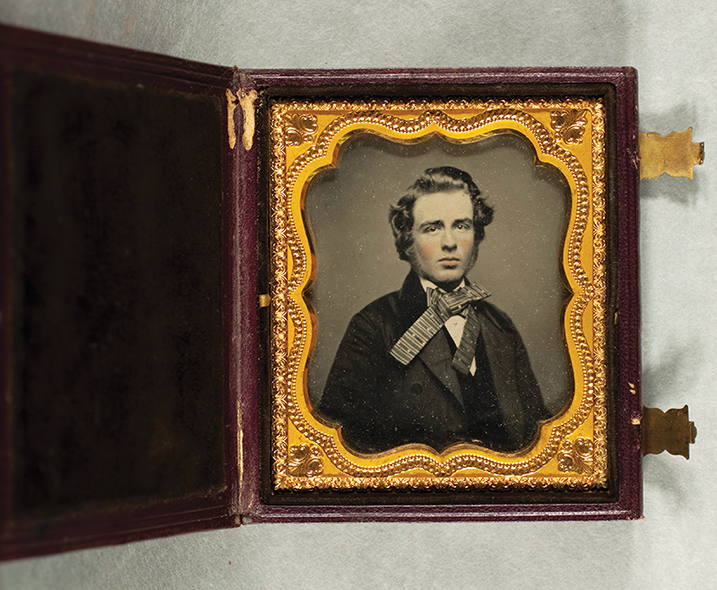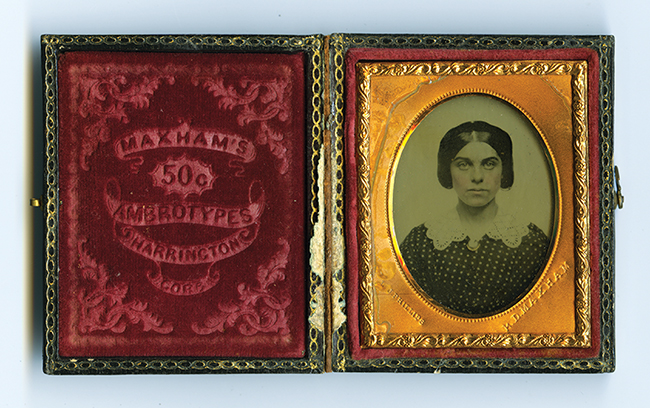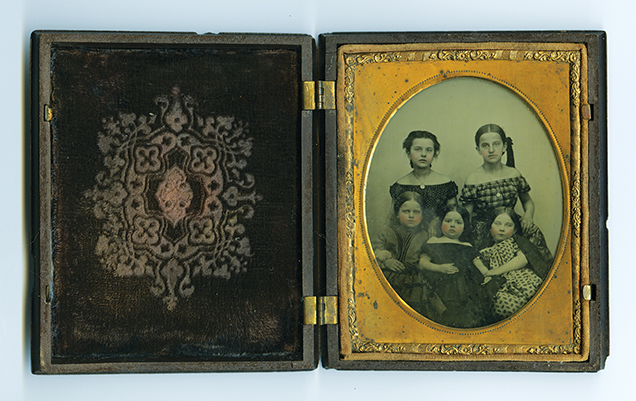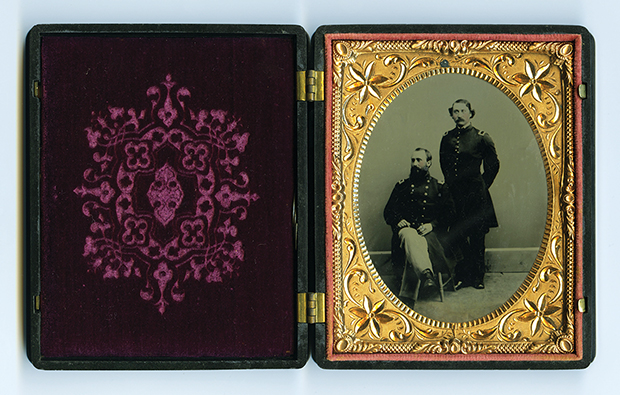Smile and Say Ambrotype
Writer Leslie Gilbert Elman
A suitably romantic portrait of Jotham Wood Taft, the Worchester, Massachusetts, businessman credited with producing the first commercially printed Valentine cards. The hand-tinted photo is set in a leather case.
Historical photos with a particular pedigree
When families gather, there’s always a chance that someone will pull out the old family photos. Vintage Instamatic snaps and Polaroids, sepia-tone studio portraits of generations past, possibly even an ambrotype.
What’s an ambrotype? It’s a specific type of photo that was widely popular for a brief time. Chances are you’ve seen one—maybe even found one among your family’s keepsakes—but you might not have known its name until now.
The history of commercial photography starts with the daguerreotype, invented in France by Louis Jacques Mandé Daguerre in 1839. In that process, a silver-coated copper plate is treated with chemicals and placed inside a darkened camera. When the camera lens is opened to light, the plate is exposed and the image is captured.

Mrs. Martha Maria Robinson, nee Bartlett, was in her 20s when she put on her polka-dot dress with the lace collar and had this portrait made at “Maxham’s 50¢ Ambrotypes” photo studio in Worchester, Massachusetts. At 2 by 2½ inches, the Ninth Plate-size photo was small enough to be portable.
This ability to capture an unadulterated image from life was revolutionary, but taking and processing a daguerreotype was time-consuming and expensive. Thus, daguerreotype photography studios catered mainly to wealthy and celebrated clients; the same people who might have had their portraits painted in oils.
For ordinary folks, preserving one’s visage for posterity tended to be cost-prohibitive until the introduction of the ambrotype (also called a collodion positive) in 1853. Devised by British sculptor Frederick Scott Archer and perfected and patented by Boston inventor/photographer James Ambrose Cutting (who gave the ambrotype its name), the ambrotype was a photograph exposed directly onto a glass plate, which was then backed with black paint or fabric to reveal its shading and contrast.
“Because of daguerreotypes, there was already a consumer expectation that you could have your picture taken,” notes Lauren Hewes, Andrew W. Mellon Curator of Graphic Arts at the American Antiquarian Society in Worcester, Massachusetts. “Ambrotypes were the newer, cheaper, more widely available technology.”
That technology spread surprisingly fast, with daguerreotype studio photographers switching to ambrotypes, new photography studios opening in cities and itinerant photographers traveling the countryside to offer their services. Photo historian and archivist Gary Saretzky estimates that more than a thousand photographers worked in New Jersey in some capacity during the 19th century. Most left behind little more than a name and occupation listed in a municipal directory, but some left a lasting legacy. Among those whose work you’ll see in prominent collections, including the Library of Congress, are Augur Judson (A. Judson & Co.) and Orrin Benjamin (O.C. Benjamin) of Newark.

Five little girls, age 3 to 12, posed for this ambrotype possibly in 1857. The pink blush on their cheeks and gold shine on their necklaces are hand-tinted to make the black-and-white photo appear more realistic. The thermoplastic union case for this photo is embossed with a depiction of Revolutionary War militia leader Francis Marion, known as the “Swamp Fox.”
At the studio of Worcester, Massachusetts, photographer Benjamin Maxham, the going rate for an ambrotype was 50 cents, affordable for a family of average means. “There are a lot of ambrotype photos of children, which was a new, emerging concept for parents,” Hewes notes. That’s partly to do with the price, but more to do with the ambrotype’s comparatively short exposure time. Sitting for a daguerreotype required the subject to remain perfectly still for 45 seconds—possibly as long as two minutes depending on the available light. For an adult, that’s difficult; for a fidgety child, nearly impossible. While not exactly “point and shoot,” ambrotype photography was quick by comparison.
Ambrotypes had other advantages over daguerreotypes as well. Because a daguerreotype was made on a mirrored surface, it had to be positioned just so to be viewed properly. “Ambrotypes are flatter and more even with the image right at the surface so it’s easier to view,” Hewes says.

“Col. Hall & Lt. Newman had their ambrotypes taken and gave them to me,” wrote Clara Barton in her diary in December 1863. This is that ambrotype, now in the collection of the American Antiquarian Society. They asked Barton to sit for a photo as well, but the founder of the American Red Cross declined. “I was not to be persuaded,” she wrote.
Curators, historians and collectors appreciate ambrotypes because they can be dated to a specific period beginning in 1853 and ending around the late 1860s with the advent of tintypes—an even newer, cheaper and thus more ubiquitous form of photography. As you might expect, given the time period, hundreds of ambrotype portraits were taken of Union and Confederate soldiers from the Civil War. Plenty of famous people sat for ambrotypes as well. One particularly rare example is an 1860 ambrotype of Abraham Lincoln, now in the Newark Public Library Special Collections.
Ambrotypes were made in standard sizes ranging from the Imperial or Mammoth Plate (larger than 6½ by 8½ inches) to a Sixteenth Plate (1½ by 1¾ inches), with the pocket-sized Sixth Plate (2¾ by 3¼ inches) and Ninth Plate (2 by 2½ inches) most common.
Like daguerreotypes, fragile ambrotypes usually were enclosed in protective cases, especially the distinctive hinged “Union Cases” fashioned from a thermoplastic made from shellac and wood powder. Embossed with decorative, classical and patriotic motifs, the velvet-lined Union Cases are as appealing to some collectors as the photos themselves.
Cherished mementos, ambrotypes also are historical artifacts that help us document the past. But more than that, they are original, one-of-a-kind works of art. Because no photographic negative exists, no duplicates were made. Notes Hewes, “Each ambrotype—like each daguerreotype—is a unique, amazing example of the photographic process.”
All photos courtesy of the American Antiquarian Society.
Leslie Gilbert Elman is the author of Weird But True: 200 Astounding, Outrageous and Totally Off the Wall Facts. She writes about antiques and other subjects for Design NJ.
